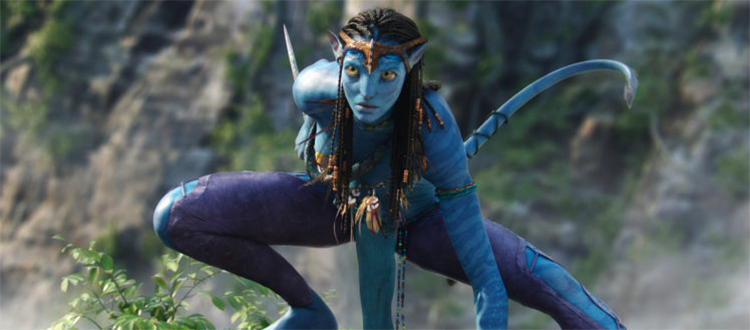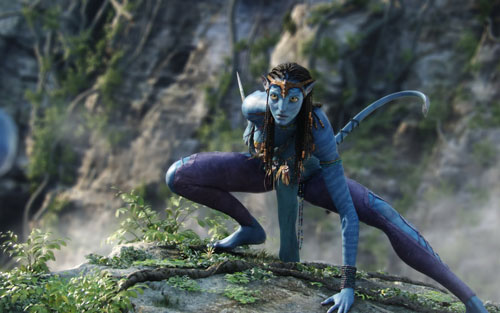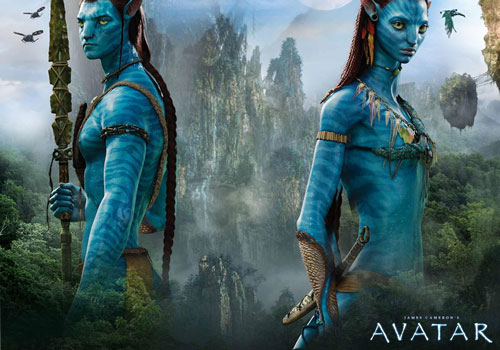Danger Gal Friday: Neytiri
“You have a strong heart. No fear. But stupid! Ignorant like a child!”
This week’s Danger Gal profile is on Neytiri from the blockbuster movie Avatar portrayed by actress Zoe Saldana.
It’s challenging to unpack my thoughts on this movie, especially keeping in mind that I have very much enjoyed Cameron’s previous films. I don’t want to have a knee-jerk fan-girl “I loved it!” response, but neither do I want to completely pan it. There are good and not-so-good elements in this movie, but I still think Neytiri stands out and is worthy of a Danger Gal profile.
One of the primary criteria for a Danger Gal profile is that the character must kick ass. I have in the past fudged a little on this point when other attributes seemed very important, but nothing like that is necessary with Neytiri. She knows herself, has confidence in her warrior abilities, and so does everyone else in her life. While certainly there are some anti-feminist aspects of her character and this movie, I tend to agree with Vocal Eyes when she says:
“Typically, women are portrayed as one or the other: the frigid one who knows better or the bimbo. The two have become mutually exclusive, as if a desire for love and sex cancels a desire for unrelated aspirations, values, and loyalties. Yet, Neytiri has it all; she is beautiful, sexual, intelligent, and follows her heart and her brain.”
“Though Neytiri’s role has been criticized as sex shaming and antifeminist, I think her place as a strong, resolute warrior woman with human desires for love and passion helps dismantle binaries between frigid women concerned with their rights and bimbos who have never heard of feminism.”
One of the main feminist criticisms of this film and of Neytiri specifically is that the character has breasts even though Cameron admitted the Na’avi aren’t “placental mammals.” This is a blatant Science Fiction world-building “FAIL” and should be acknowledged as such. Having said that, Na’avi of both genders are portrayed as variations of mammals. Female Na’avi have breasts, but male Na’avi are built like caricatures of male mammals with the inverted “V” body shape prevalent in Romance genre heroes — extremely broad shoulders and narrow hips. To be blunt, I’m surprised there haven’t been more crude jokes about what Na’avi -Jake is hiding under that loin cloth. In that aspect, I think the objectification is fairly equal. The world-building fail had a purpose and that was to enable human mammals (i.e., the audience) to relate—and root for the Na’avi. Moreover, despite Cameron’s enthusiasm for this aspect of the story, Neytiri is not defined by this attribute. In contrast to male Na’avi forms, Neytir’s body shape is not really a caricature of the female one as compared to other female cartoon characters like Jessica Rabbit.
On the subject of bodies, FlowTV has a thoughtful article called “I See You?: Gender and Disability in Avatar” by Michael Peterson, Laurie Beth Clark, and Lisa Nakamura that critiques the story’s message on disabilities:
“When Jack Sully transmits his consciousness into the hybrid Na’avi body that he eventually comes to occupy permanently, a world of limits is evoked. We can see that the bias against disabled people is exactly the same in the future as it is at present—Sully’s spinal injury is repairable, but he can’t afford it. However, as we see during the avatar-training scenes, the disabled body is viewed as “waste” that a thrifty military industrial complex can recoup—Sully is given the ability to acquire a prosthetic alien-soldier body not as compensation for his disability, but in spite of it—his genomic capital as the identical twin to his scientist-brother makes him the only possible match for the cloned Na’avi body, a technology far more expensive and precious than his own defective body.”
The idea of the body being viewed as “disposable” and “waste” seems to fit with the posthuman, almost cyberpunk, world Jake’s world has turned into. In many cyberpunk stories, the body is merely “meat” and considered disposable or at least undesirable without cyber upgrades. Also, Jakes world, where people have to wear masks against toxic air, doesn’t sound that distant from the world of Blade Runner. IO9 describes this world as the following:
First up, it gives us a look at what’s become of Earth. Turns out we’ve destroyed the planet—people wear clean-air breathing masks, the world is cluttered with ads, and sounds like a cold, concrete place. At least, that’s the world that poor and unfortunate Jake Sully calls home.
Also, I have to wonder what the discussion would have been like had Jake’s character been a female paraplegic. How would we view this idea of the body as not only disposable, but also something to completely reject, as Jake does at the end of the story?
Many critics have denigrated the movie as being just another “going native” derivative work, but commenter Pastabagel over at Metafilter makes a different observation:
“… we implicity believe that science = good and religions other than today’s mainline established ones are backward or pagan, which = bad. So the natives had to be civilized and brought forward into the present out of the past, and anyone that fought back wasn’t fighting only the invader, they were fighting civilization, science and progress itself… So Cameron has eliminated the casting of the Na’vi as being in need of civilization. They don’t need it, they don’t want it, and what they already naturally have is in many respects better. So the audience now understands that it isn’t simply – stubbornness of fear of change underlying Na’vi rejection of humans gifts to them. It’s that the Na’vi simply don’t need what the humans are offering.”
There are two main differences, as I see it, between Avatar and other “going native” stories: (1) the enlightened spirituality of the Na’avi is objectively verifiable in the story, and (2) when Jake goes native there is no going back. Viewers can’t write off the Na’avi idea of Eywa as some kind of “New Age mojo” because the scientist in the story (a woman, but more on that later) verifies that it’s in fact a real, biological network.
One of the aspects of this movie that struck me and I haven’t seen criticized elsewhere was that, with the exception of Michelle Rodriguez, all of the Naâ’avi are portrayed by non-white actors and all of the non-Na’avi characters are portrayed by white actors. This thematically reinforces the erroneous idea of the “noble savage” that the objective nature of the planet is attempting to subvert. I would much rather have seen more ethnic diversity on both sides of the story’s conflict. IO9’s Annalee Newitz explores some of these ideas in “When will white people stop making movies like Avatar?”
Likewise, gender assumptions are functioning similarly in that on the human side of the conflict, all of those who want to destroy the Na’avi are male and it’s a human female scientist who recognizes the error. While I loved that Cameron created a scientist who also happens to be female “something we need to see more often — there are overtones that she sees the mother in Pandora’s “‘mother nature'” precisely because of her femaleness.
On balance, I enjoyed Avatar and relished in Neytiri’s experiences. She is a strong character with her own arc and is not written as the stereotypical sidekick, or as Jezebel put it “handbags” or “girlfriend parts.” A formidable warrior, Neytiri is Jake Sully’s mentor not just in the softer emotions of falling love, but in the Na’avi art of war. Avatar is also another example of a Science Fiction Romance that doesn’t skimp on the world-building, science, or character relationships.
Having said that, I can’t help but wonder what this movie would have been like had the main point-of-view character been female and we’d seen more ethnic diversity on both sides of the story’s conflict. On this idea, Cameron should remember what has been said about him:
Gale Anne Hurd, Cameron’s second wife, and the producer of his first three films, says that Cameron always found women more interesting than men as protagonists. “He felt that they were underutilized in sci-fi, action, and fantasy,” she said. “And that just about everything you could explore in a male action hero could be explored better with a woman.”



